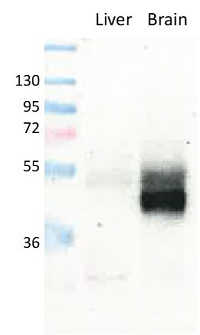anti-GLUT1 pAb (IN116)
| Code | Size | Price |
|---|
| AG-25B-0040-C050 | 50 ug | £200.00 |
Quantity:
Prices exclude any Taxes / VAT
Overview
Host Type: Rabbit
Antibody Clonality: Polyclonal
Regulatory Status: RUO
Target Species:
- Human
- Mouse
- Rat
Applications:
- Immunohistochemistry (IHC)
- Immunoprecipitation (IP)
- Western Blot (WB)
Shipping:
BLUE ICE
Storage:
Short Term Storage: +4?C. Long Term Storage: -20?C
Images
Documents
Further Information
Alternate Names/Synonyms:
Solute Carrier Family 2, Facilitated Glucose Transporter Member 1; SLC2A1; Glucose Transporter Type 1, Erythrocyte/Brain; HepG2 Glucose Transporter
Concentration:
1mg/ml
EClass:
32160000
Form (Short):
liquid
Formulation:
Liquid. In PBS containing 10% glycerol and 0.02% Proclin 300.
Handling Advice:
After opening, prepare aliquots and store at -20°C. Avoid freeze/thaw cycles.
Immunogen:
A synthetic peptide corresponding to 15 aa located near the C-terminus of human GLUT1.
Long Description:
Polyclonal Antibody. Recognizes human, mouse and rat GLUT1. Does not detect GLUT2. Applications: IHC, IP, WB. Source: Rabbit. GLUT1 belongs to the family of glucose transporters (GLUTs, encoded by the SLC2A genes), which comprises 14 isoforms. GLUT1, the uniporter protein encoded by the SLC2A1 gene, is a key rate-limiting factor in the transport of glucose. It is composed of twelve transmembrane segments of the protein and an intracellular N- and C-terminus are forming the protein pore. In normal tissues, GLUT1 is limited to being expressed on erythrocytes and endothelial cells in the blood-brain barriers. GLUT1 is located at the blood-brain barrier and assures the transport of glucose (the most important energy carrier of the brain) into the brain. The genetic defect of Glut1 is known as the Glut1 deficiency syndrome (Glut1-DS) and is characterized by early infantile seizures, developmental delay, microcephaly and ataxia. GLUT1 is a pivotal rate-limiting element in the transport of glucose in malignancy cells and is overexpressed in different types of human cancers. GLUT1 is involved in the progression and metastasis of cancer cells.
NCBI, Uniprot Number:
P11166
Package Type:
Plastic Vial
Product Description:
GLUT1 belongs to the family of glucose transporters (GLUTs, encoded by the SLC2A genes), which comprises 14 isoforms. GLUT1, the uniporter protein encoded by the SLC2A1 gene, is a key rate-limiting factor in the transport of glucose. It is composed of twelve transmembrane segments of the protein and an intracellular N- and C-terminus are forming the protein pore. In normal tissues, GLUT1 is limited to being expressed on erythrocytes and endothelial cells in the blood-brain barriers. GLUT1 is located at the blood-brain barrier and assures the transport of glucose (the most important energy carrier of the brain) into the brain. The genetic defect of Glut1 is known as the Glut1 deficiency syndrome (Glut1-DS) and is characterized by early infantile seizures, developmental delay, microcephaly and ataxia. GLUT1 is a pivotal rate-limiting element in the transport of glucose in malignancy cells and is overexpressed in different types of human cancers. GLUT1 is involved in the progression and metastasis of cancer cells.
Purity:
>95% (SDS-PAGE)
Source / Host:
Rabbit
Specificity:
Recognizes human, mouse and rat GLUT1. Does not detect GLUT2.
Transportation:
Non-hazardous
UNSPSC Category:
Primary Antibodies
UNSPSC Number:
12352203
Use & Stability:
Stable for at least 1 year after receipt when stored at -20°C.
References
Expression of the human erythrocyte glucose transporter in Escherichia Coli: H.K. Sarkar, et al.; PNAS 85, 5463 (1988) | Differential localization of two glucose transporter isoforms in kidney: B. Thorens, et al.; Am. J. Physiol. 259, C286 (1990)



